
The United States has created more than 10 million jobs in the past four years. Over this time, the unemployment rate fell from 8.2% to 4.9%, the lowest in nearly a decade.
In most U.S. cities, the story is the same. A majority of metropolitan areas have added jobs in recent years, and most reported declines in unemployment. In 56 metro areas, however, total employment fell over the last four years. The Atlantic City-Hammonton metro area had the largest employment decline, with the number of jobs dropping by 6.8% since June 2012.
Changes in an area’s total number of jobs are often largely explained by the industrial composition of a city’s economy. In an interview with 24/7 Wall St., Martin Kohli, chief regional economist at the Bureau of Labor Statistics, said, “Different industries tend to expand at different rates.” He added that in the United States today, “energy prices are depressed, and that means slower metropolitan area growth in areas that have large concentrations of energy extraction industries.”
Click here to see the cities losing the most jobs
Since 2012, employment in the mining and logging industry fell by 19.7% nationwide. Mining and logging was the only industry to shrink in the last four years at the national level, hurting the economies of many metropolitan areas dependent on the sector. In close to one third of the metro areas where employment declined in the last four years, the mining, logging, and construction sectors employ a larger share of the area workforce than the national proportion.
Relatively large job losses were also common in metropolitan area government sectors. Kohli explained that while no single explanation can account for local government job losses, sustained major financial distress during the recession is a likely factor for many of these areas. “The federal government has not really grown, in part because Congress and policymakers don’t want to spend more money on government salaries.” The same rationale likely holds in many of the metro areas shedding the most jobs.
People usually do not move to an area unless there are jobs or some other opportunity available, and therefore population and employment changes are closely related. In nearly every city where employment fell over the past four years, the population also declined significantly. The opposite was the case in metro areas adding jobs, most notably cities in the southern and southwestern regions of the country.
“The southern and southwestern parts of the country have been growing much more rapidly than the northeastern part of the country, which [has led] to stronger job growth in the South and West,” Kohli said.
In some of the cities shedding jobs, employment fell even as the population expanded. In Casper, Wyoming, for example, the total number of jobs fell from 40,115 to 37,649, while the number of residents grew by 4.4%. In these relatively unusual cases, it seems people are moving into the area despite signs of a weak economy. In four of the metro areas where the population increased while jobs declined, the unemployment rate also rose over the past four years.
To identify the cities losing the most jobs, 24/7 Wall St. reviewed the 56 metropolitan statistical areas where the number people employed declined from June 2012 through June 2016. Employment levels are seasonally adjusted from the Bureau of Labor Statistics. Unemployment rates and industry employment data also came from the BLS, and were seasonally adjusted. Population figures as of July 2012 and July 2015 came from the U.S. Census Bureau.
These are the cities losing the most jobs.

56. Staunton-Waynesboro, VA
> Employment decline: -0.3%
> Number of jobs June 2012: 55,120
> Number of jobs June 2016: 54,970
> Unemployment rate June 2016: 3.5%
Total employment in Staunton-Waynesboro fell by 0.3% over the past four years, one of the largest declines of any metro area. The metro area’s government lost roughly 200 workers, the most of any sector.

55. Carbondale-Marion, IL
> Employment decline: -0.4%
> Number of jobs June 2012: 56,076
> Number of jobs June 2016: 55,832
> Unemployment rate June 2016: 6.0%
Employment in the Carbondale-Marion metro area fell by 0.4% over the past four years, one of the largest contractions nationwide. The largest loss occurred in the government sector, which decreased by approximately 2,300 employees.

54. Lynchburg, VA
> Employment decline: -0.4%
> Number of jobs June 2012: 116,013
> Number of jobs June 2016: 115,501
> Unemployment rate June 2016: 4.2%
Employment in the Lynchburg metro area fell by 0.4%, one of the largest declines in the country. The largest loss occurred in the government sector, which decreased by approximately 400 employees.

53. Springfield, IL
> Employment decline: -0.4%
> Number of jobs June 2012: 105,998
> Number of jobs June 2016: 105,522
> Unemployment rate June 2016: 4.8%
Total employment in Springfield has fallen by 0.4% since 2012, while nationwide it has grown by 7.6%. The metro area’s financial industry lost the most employees. Employment in the sector fell by roughly 800 workers.

52. Lawton, OK
> Employment decline: -0.5%
> Number of jobs June 2012: 50,605
> Number of jobs June 2016: 50,362
> Unemployment rate June 2016: 4.7%
Much of the employment decline in Lawton was likely due to workers leaving the metro area. The population decreased by 1.6% between 2012 and 2015, one of the largest such declines in the country.

51. Wheeling, WV-OH
> Employment decline: -0.5%
> Number of jobs June 2012: 62,490
> Number of jobs June 2016: 62,179
> Unemployment rate June 2016: 6.8%
The total number of jobs in Wheeling fell from 62,490 to 62,179 over the past four years. The 0.5% decline was one of the largest of any metro area.

50. Rocky Mount, NC
> Employment decline: -0.6%
> Number of jobs June 2012: 61,596
> Number of jobs June 2016: 61,236
> Unemployment rate June 2016: 6.9%
Employment decline in Rocky Mount may be due to residents leaving the metro area. Between 2012 and 2015, the metro area population fell by 1.9%, one of the largest such declines in the country.

49. Houma-Thibodaux, LA
> Employment decline: -0.6%
> Number of jobs June 2012: 91,094
> Number of jobs June 2016: 90,557
> Unemployment rate June 2016: 6.5%
Many of the jobs lost in Houma-Thibodaux were in its second largest sector, government. Employment in the government sector fell by 8.4%, one of the largest contractions of any metro area.

48. Syracuse, NY
> Employment decline: -0.6%
> Number of jobs June 2012: 296,941
> Number of jobs June 2016: 295,035
> Unemployment rate June 2016: 4.5%
While total employment in the U.S. grew by 7.6% over the past four years, it fell by 0.6% in Syracuse. Some industries in the area added jobs, but the gains were not enough to offset large losses in other sectors. The metro area’s professional and business services industry lost the most employees. Employment in the sector fell by roughly 2,300 workers.

47. Youngstown-Warren-Boardman, OH-PA
> Employment decline: -0.7%
> Number of jobs June 2012: 238,457
> Number of jobs June 2016: 236,850
> Unemployment rate June 2016: 6.2%
Employment in the Youngstown-Warren-Boardman metro area fell by 0.7% over the past four years, one of the largest contractions nationwide. The biggest losses occurred in the durable goods industry, which shrank by roughly 2,600 employees.

46. Decatur, AL
> Employment decline: -0.7%
> Number of jobs June 2012: 65,744
> Number of jobs June 2016: 65,263
> Unemployment rate June 2016: 6.0%
The bulk of the Decatur metro area’s employment decline occurred in its third largest sector, government. The number of people employed in Decatur’s government fell by 7.7%, while nationwide it grew by 0.9%.

45. Albany, GA
> Employment decline: -0.8%
> Number of jobs June 2012: 63,030
> Number of jobs June 2016: 62,517
> Unemployment rate June 2016: 6.0%
Employment declines in Albany may be due to residents leaving the metro area. Between 2012 and 2015, the metro area population fell by 2.4%, the ninth largest decline in the country.

44. Columbus, GA-AL
> Employment decline: -0.9%
> Number of jobs June 2012: 118,393
> Number of jobs June 2016: 117,316
> Unemployment rate June 2016: 6.1%
Total employment in Columbus has fallen by 0.9% since 2012, while nationwide it grew by 7.6%. The largest loss occurred in the area’s manufacturing industry, which decreased by approximately 800 employees.

43. Glens Falls, NY
> Employment decline: -0.9%
> Number of jobs June 2012: 58,175
> Number of jobs June 2016: 57,644
> Unemployment rate June 2016: 4.7%
Employment in the Glens Falls metro area fell by 0.9% over the past four years, one of the largest contractions in the country. The largest loss in employment occurred in the area’s manufacturing industry.

42. Vineland-Bridgeton, NJ
> Employment decline: -0.9%
> Number of jobs June 2012: 61,698
> Number of jobs June 2016: 61,113
> Unemployment rate June 2016: 7.7%
Many of the jobs lost in Vineland-Bridgeton were in its largest sector, government. Employment in government fell by 11.2%, one of the largest contractions nationwide.

41. Johnson City, TN
> Employment decline: -1.0%
> Number of jobs June 2012: 86,299
> Number of jobs June 2016: 85,421
> Unemployment rate June 2016: 4.9%
Total employment in Johnson City has fallen by 1.0% since 2012, while nationwide it grew by 7.6%. The metro area’s mining, logging, and construction industry lost the most employees. Employment in the sector fell by roughly 300 workers.

40. Waterloo-Cedar Falls, IA
> Employment decline: -1.1%
> Number of jobs June 2012: 87,011
> Number of jobs June 2016: 86,013
> Unemployment rate June 2016: 4.9%
Many of the jobs lost in Waterloo-Cedar Falls were in its largest sector, manufacturing. Employment in the manufacturing industry fell by 8.0%, one of the largest contractions nationwide.
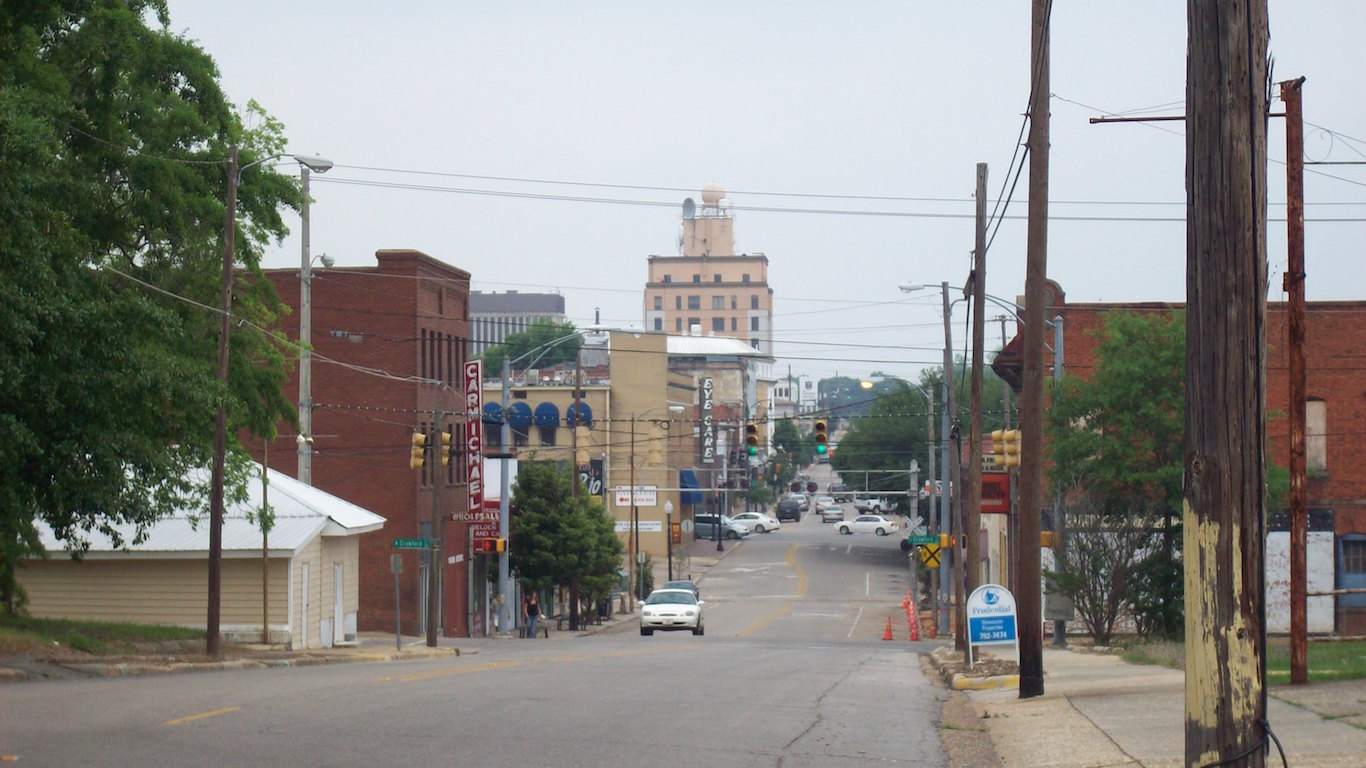
39. Dothan, AL
> Employment decline: -1.2%
> Number of jobs June 2012: 59,393
> Number of jobs June 2016: 58,685
> Unemployment rate June 2016: 6.0%
The total number of jobs in Dothan fell from 59,393 to 58,685 over the past four years. The 1.2% decline was one of the largest of any metro area.

38. Harrisonburg, VA
> Employment decline: -1.3%
> Number of jobs June 2012: 60,715
> Number of jobs June 2016: 59,953
> Unemployment rate June 2016: 3.8%
The bulk of the Harrisonburg metro area’s employment decline occurred in its third largest sector, retail trade. Employment in the retail trade industry fell by 2.9%, while nationwide it grew by 7.8%.

37. Kingsport-Bristol-Bristol, TN-VA
> Employment decline: -1.3%
> Number of jobs June 2012: 133,251
> Number of jobs June 2016: 131,541
> Unemployment rate June 2016: 4.8%
Many of the jobs lost in the Kingsport metro area were in its second largest sector, manufacturing. Employment in the industry fell by 5.4% over the past four years, while nationwide manufacturing grew by 2.9% over that period.

36. Parkersburg-Vienna, WV
> Employment decline: -1.4%
> Number of jobs June 2012: 37,714
> Number of jobs June 2016: 37,197
> Unemployment rate June 2016: 5.8%
Over the past four years, the total number of jobs in Parkersburg-Vienna fell from 37,714 to 37,197 workers. The 1.4% decline was one of the largest of any metro area.

35. Warner Robins, GA
> Employment decline: -1.6%
> Number of jobs June 2012: 78,367
> Number of jobs June 2016: 77,087
> Unemployment rate June 2016: 5.3%
The bulk of the Warner Robins metro area’s employment decline occurred in its largest sector, government. Employment in government fell by 6.6%, while nationwide it grew by 0.9%.

34. Shreveport-Bossier City, LA
> Employment decline: -1.7%
> Number of jobs June 2012: 183,306
> Number of jobs June 2016: 180,246
> Unemployment rate June 2016: 6.6%
Much of the employment decline in Shreveport-Bossier City is likely due to workers leaving the metro area. The population decreased by 1.0% between 2012 and 2015, one of the largest such declines in the country.

33. Hinesville, GA
> Employment decline: -1.7%
> Number of jobs June 2012: 30,922
> Number of jobs June 2016: 30,393
> Unemployment rate June 2016: 5.5%
The total number of jobs in Hinesville declined by 1.7% over the past four years, while nationwide it grew by 7.6%. Many residents who lost or left their jobs likely moved out of the metro area. The population of Hinesville fell by 1.7%, one of the largest declines of any metropolitan area.
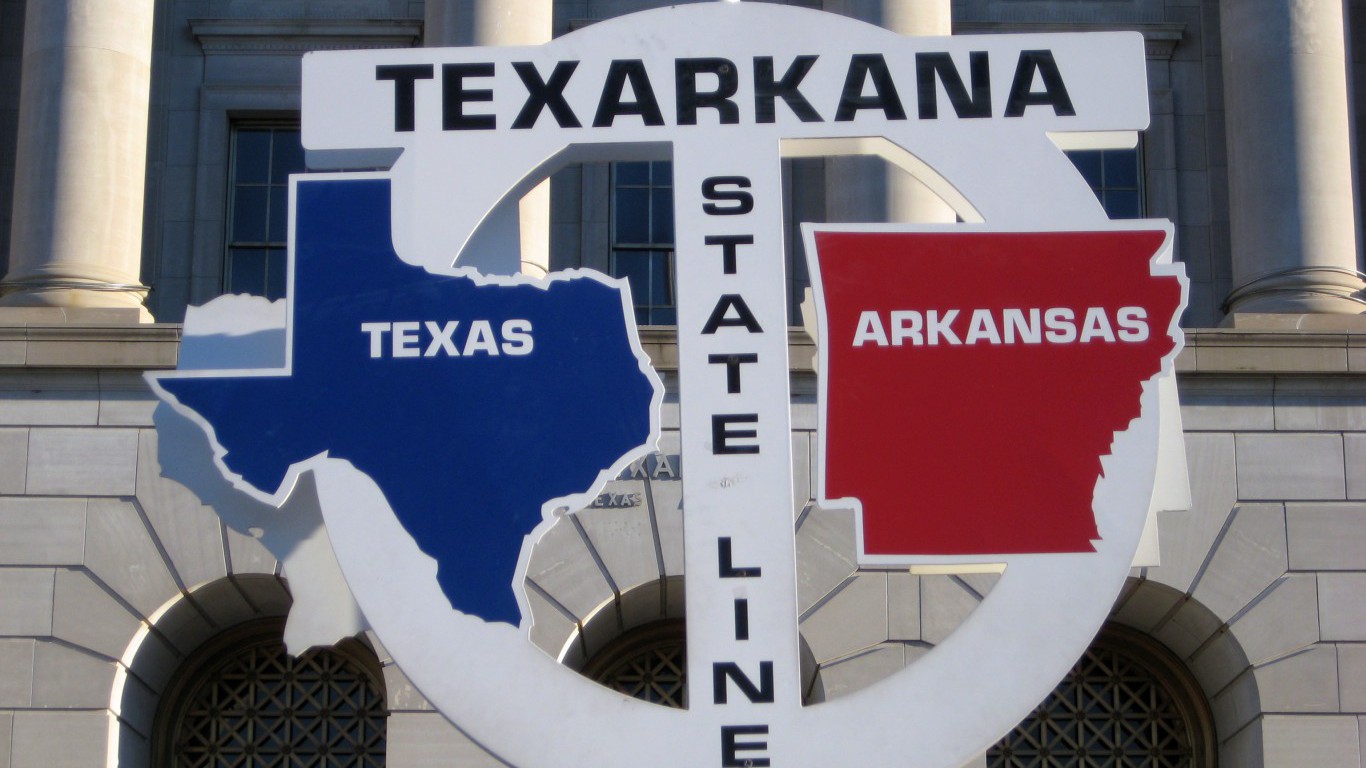
32. Texarkana, TX-AR
> Employment decline: -1.8%
> Number of jobs June 2012: 63,356
> Number of jobs June 2016: 62,216
> Unemployment rate June 2016: 4.2%
The bulk of the Texarkana metro area’s employment decline occurred in its largest sector, government. Government employment fell by 9.5%, while nationwide it grew by 0.9%.

31. Grand Island, NE
> Employment decline: -1.8%
> Number of jobs June 2012: 43,485
> Number of jobs June 2016: 42,701
> Unemployment rate June 2016: 3.3%
Total employment in Grand Island fell by 1.8% since 2012, while nationwide it grew by 7.6%. The unemployment rate dropped from 3.9% to 3.3% over the same period — one of the smallest improvements of any metro area economy.

30. Weirton-Steubenville, WV-OH
> Employment decline: -1.9%
> Number of jobs June 2012: 50,319
> Number of jobs June 2016: 49,352
> Unemployment rate June 2016: 7.5%
The Weirton-Steubenville economy is in relatively poor shape. In addition to a 1.9% decline in employment over the last four years, the 7.5% unemployment rate is one of the highest of any metro area.

29. Cumberland, MD-WV
> Employment decline: -2.0%
> Number of jobs June 2012: 41,802
> Number of jobs June 2016: 40,978
> Unemployment rate June 2016: 6.1%
Total employment in Cumberland fell by 2.0% over the past four years, while nationwide it grew by 7.6%. The metro area’s government sector lost the most employees. Government employment fell by roughly 700 workers.

28. Mansfield, OH
> Employment decline: -2.0%
> Number of jobs June 2012: 51,340
> Number of jobs June 2016: 50,304
> Unemployment rate June 2016: 5.4%
The bulk of the Mansfield metro area’s employment decline occurred in its largest sector, trade, transportation, and utilities. Employment in the sector fell by 3.9%, while nationwide it grew by 7.4%.
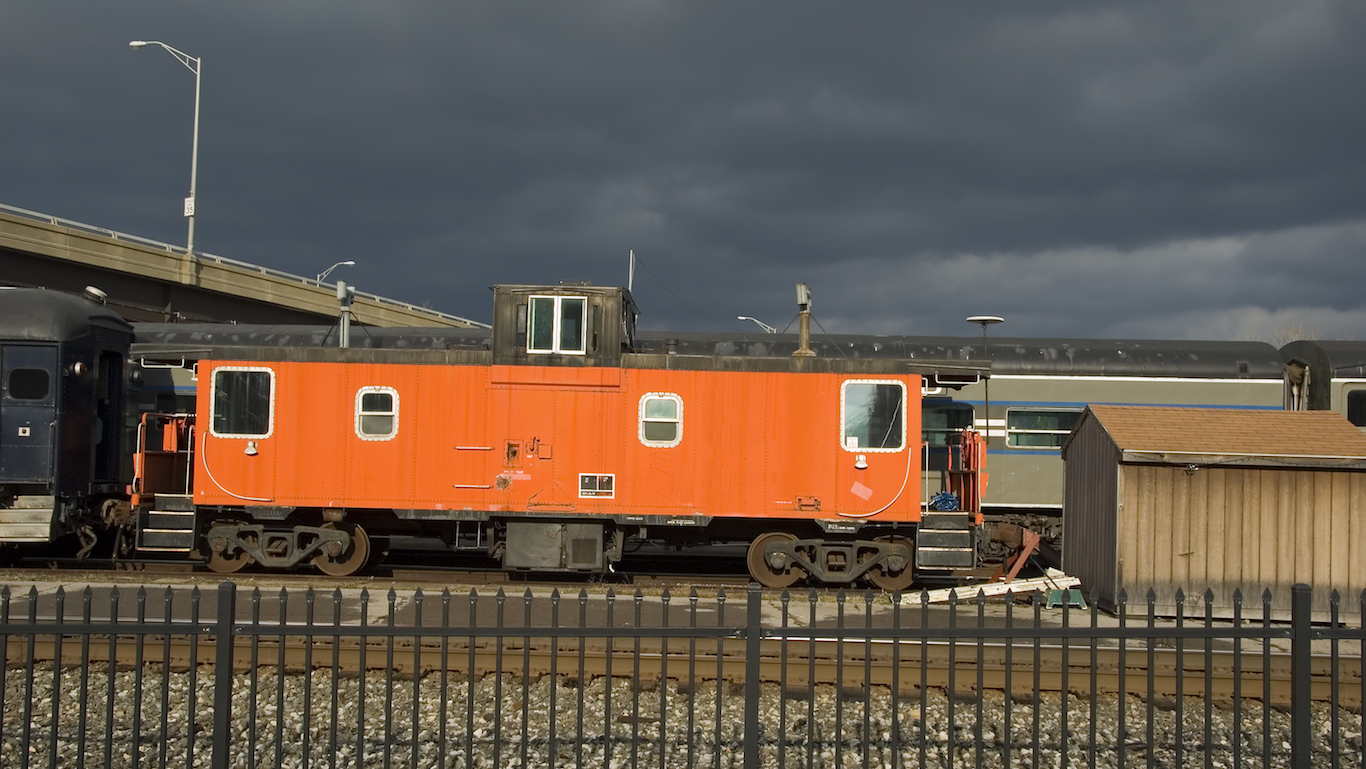
27. Utica-Rome, NY
> Employment decline: -2.1%
> Number of jobs June 2012: 127,338
> Number of jobs June 2016: 124,702
> Unemployment rate June 2016: 4.6%
The bulk of the Utica-Rome metro area’s employment decline occurred in its largest sector, government. Employment in government fell by 4.8%, while nationwide it grew by 0.9%.

26. Walla Walla, WA
> Employment decline: -2.1%
> Number of jobs June 2012: 28,984
> Number of jobs June 2016: 28,372
> Unemployment rate June 2016: 5.7%
The total number of jobs in Walla Walla fell by 2.1% over the past four years, while nationwide it grew by 7.6%. The largest loss in employment occurred in the metro area’s information industry.

25. Williamsport, PA
> Employment decline: -2.1%
> Number of jobs June 2012: 57,606
> Number of jobs June 2016: 56,375
> Unemployment rate June 2016: 6.6%
Total employment in Williamsport fell by 2.1% over the past four years, while nationwide it grew by 7.6%. The largest loss occurred in the manufacturing industry, which decreased by approximately 500 employees.

24. Sebring, FL
> Employment decline: -2.5%
> Number of jobs June 2012: 33,625
> Number of jobs June 2016: 32,791
> Unemployment rate June 2016: 6.5%
The total number of jobs in Sebring fell from 33,625 to 32,791 over the past four years. The 2.5% decline was one of the largest of any metro area.

23. Huntington-Ashland, WV-KY-OH
> Employment decline: -2.7%
> Number of jobs June 2012: 143,104
> Number of jobs June 2016: 139,290
> Unemployment rate June 2016: 5.9%
The number of jobs in the Huntington-Ashland metro area declined by 2.7% over the past four years, one of the largest contractions nationwide. The metro area’s mining, logging, and construction industry lost the most employees. Employment in the sector fell by roughly 2,100 workers.

22. Lafayette, LA
> Employment decline: -2.7%
> Number of jobs June 2012: 212,949
> Number of jobs June 2016: 207,164
> Unemployment rate June 2016: 7.0%
Lafayette is one of the only metro areas where the population grew over the last four years as the number of jobs fell. The influx of people does not appear to have improved the economy, however. Lafayette’s unemployment increased from 5.8% of the workforce to 7.0% over that time.

21. Gulfport-Biloxi-Pascagoula, MS
> Employment decline: -2.8%
> Number of jobs June 2012: 157,904
> Number of jobs June 2016: 153,490
> Unemployment rate June 2016: 6.3%
Employment in the Gulfport-Biloxi-Pascagoula metro area fell by 2.8% over the past four years, one of the largest contractions nationwide. The metro area’s professional and business services industry lost the most employees. Employment in the sector fell by roughly 2,600 workers.

20. Longview, TX
> Employment decline: -2.8%
> Number of jobs June 2012: 98,388
> Number of jobs June 2016: 95,600
> Unemployment rate June 2016: 5.9%
The total number of jobs in Longview fell from 98,388 to 95,600 over the past four years. The 2.8% decline was one of the largest of any metro area.

19. Owensboro, KY
> Employment decline: -3.0%
> Number of jobs June 2012: 52,990
> Number of jobs June 2016: 51,390
> Unemployment rate June 2016: 4.6%
The total number of jobs in Owensboro fell by 3.0% over the past four years, while nationwide it grew by 7.6%. The largest loss occurred in the professional and business services industry, which decreased by approximately 400 employees.
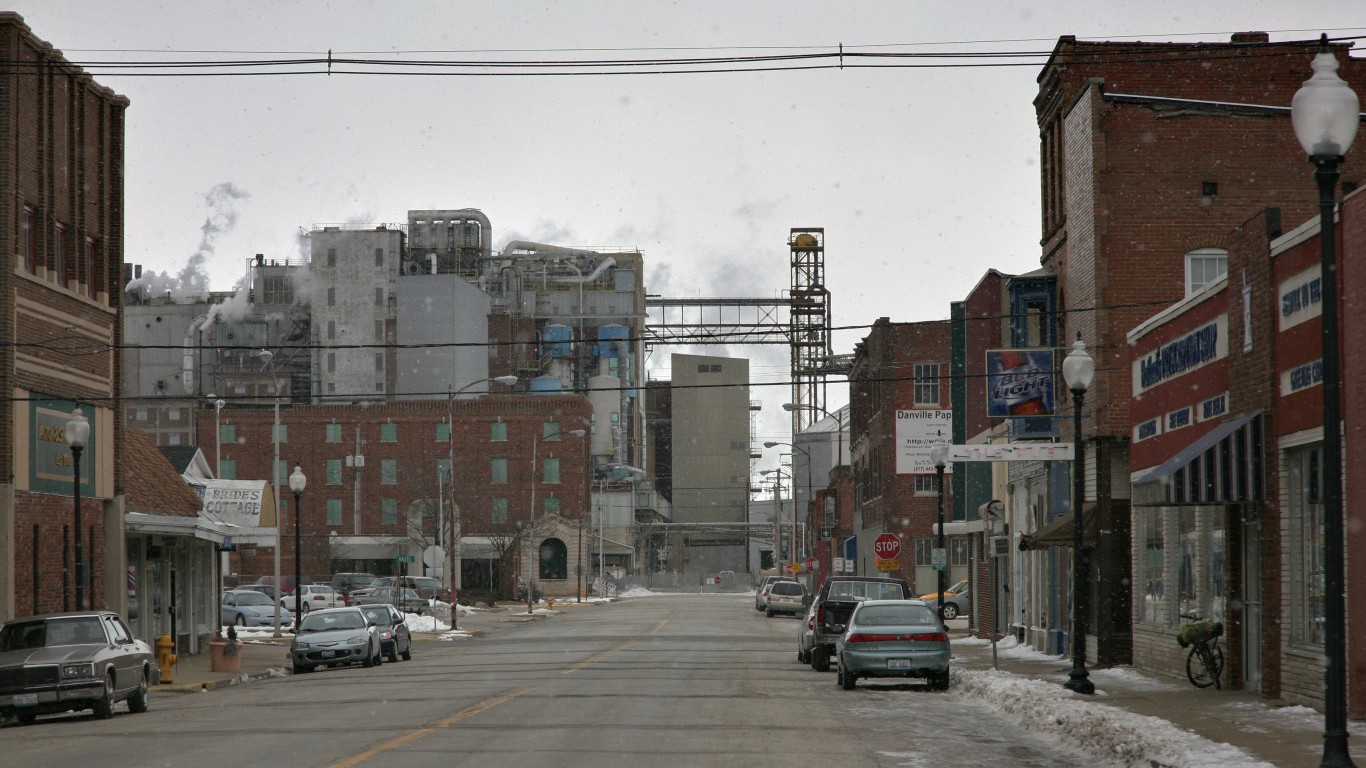
18. Danville, IL
> Employment decline: -3.1%
> Number of jobs June 2012: 33,796
> Number of jobs June 2016: 32,751
> Unemployment rate June 2016: 7.2%
Much of the employment decline in Danville was likely due to workers leaving the metro area. The population decreased by 1.9% between 2012 and 2015, one of the largest such declines in the country.

17. Wichita Falls, TX
> Employment decline: -3.3%
> Number of jobs June 2012: 64,086
> Number of jobs June 2016: 61,962
> Unemployment rate June 2016: 4.2%
The number of people employed in Wichita Falls fell from 64,086 to 61,962 over the past four years. The 3.3% decline was one of the largest of any metro area.

16. Johnstown, PA
> Employment decline: -3.6%
> Number of jobs June 2012: 59,965
> Number of jobs June 2016: 57,801
> Unemployment rate June 2016: 6.8%
One reason for the loss of workers in Johnstown may be population decline. Between 2012 and 2015, the metro area population fell by 3.6%, the fourth largest decline in the country.

15. Charleston, WV
> Employment decline: -3.7%
> Number of jobs June 2012: 96,339
> Number of jobs June 2016: 92,759
> Unemployment rate June 2016: 5.5%
Total employment in Charleston fell by 3.7% over the past four years, while nationwide it grew by 7.6%. Over roughly the same period, the population fell by 2.3%, the 10th largest decline in the country.

14. Davenport-Moline-Rock Island, IA-IL
> Employment decline: -3.8%
> Number of jobs June 2012: 183,561
> Number of jobs June 2016: 176,601
> Unemployment rate June 2016: 5.8%
Many of the jobs lost in Davenport-Moline-Rock Island were in its largest sector, trade, transportation, and utilities. Employment in the trade, transportation, and utilities industry fell by 5.6%, one of the largest contractions nationwide.
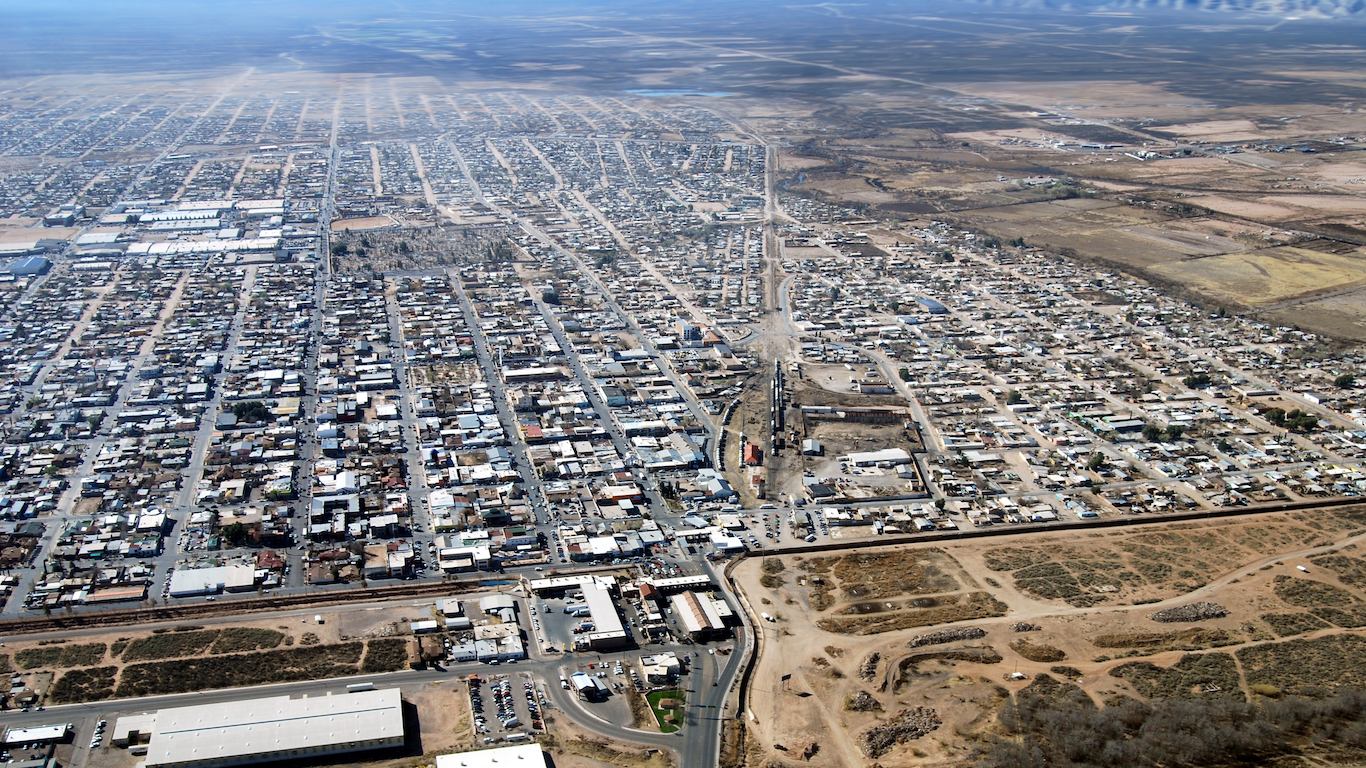
13. Sierra Vista-Douglas, AZ
> Employment decline: -4.0%
> Number of jobs June 2012: 49,220
> Number of jobs June 2016: 47,268
> Unemployment rate June 2016: 6.7%
Much of the employment decline in Sierra Vista-Douglas was likely due to workers leaving the metro area. The population decreased by 4.1% between 2012 and 2015, the second largest decline in the country.

12. Anniston-Oxford-Jacksonville, AL
> Employment decline: -4.1%
> Number of jobs June 2012: 45,195
> Number of jobs June 2016: 43,335
> Unemployment rate June 2016: 6.7%
Total employment in Anniston-Oxford-Jacksonville fell by 4.1% over the past four years, while nationwide it grew by 7.6%. The largest loss in employment occurred in the metro area’s professional and business services industry.

11. Homosassa Springs, FL
> Employment decline: -4.5%
> Number of jobs June 2012: 46,044
> Number of jobs June 2016: 43,995
> Unemployment rate June 2016: 6.5%
Employment in the Homosassa Springs metro area fell by 4.5%, the 11th largest decline in the country. The biggest losses occurred in the government sector, which shrank by roughly 500 employees.

10. Fairbanks, AK
> Employment decline: -4.6%
> Number of jobs June 2012: 45,297
> Number of jobs June 2016: 43,195
> Unemployment rate June 2016: 5.6%
Many of the jobs lost in Fairbanks were in its largest sector, government. The number of area residents employed by the local government fell by 9.9% over the past four years, one of the largest contractions nationwide.

9. Elmira, NY
> Employment decline: -4.8%
> Number of jobs June 2012: 37,121
> Number of jobs June 2016: 35,345
> Unemployment rate June 2016: 5.2%
The total number of jobs in Elmira fell by 4.8% over the past four years, while nationwide it grew by 7.6%. Many of the workers who lost or left their jobs were likely among the many residents moving out of Elmira. The metro area population fell by 2.5%, the eighth largest decline in the country.

8. Bloomington, IL
> Employment decline: -4.9%
> Number of jobs June 2012: 96,541
> Number of jobs June 2016: 91,848
> Unemployment rate June 2016: 5.2%
While total employment in the U.S. grew by 7.6% over the past four years, it fell by 4.9% in Bloomington. The metro area’s professional and business services industry lost the most employees. Employment in the sector fell by roughly 1,500 workers.

7. Decatur, IL
> Employment decline: -5.4%
> Number of jobs June 2012: 48,935
> Number of jobs June 2016: 46,297
> Unemployment rate June 2016: 6.9%
Much of the employment decline in Decatur was likely due to workers leaving the metro area. The population decreased by 2.5% between 2012 and 2015, the sixth largest decline in the country.
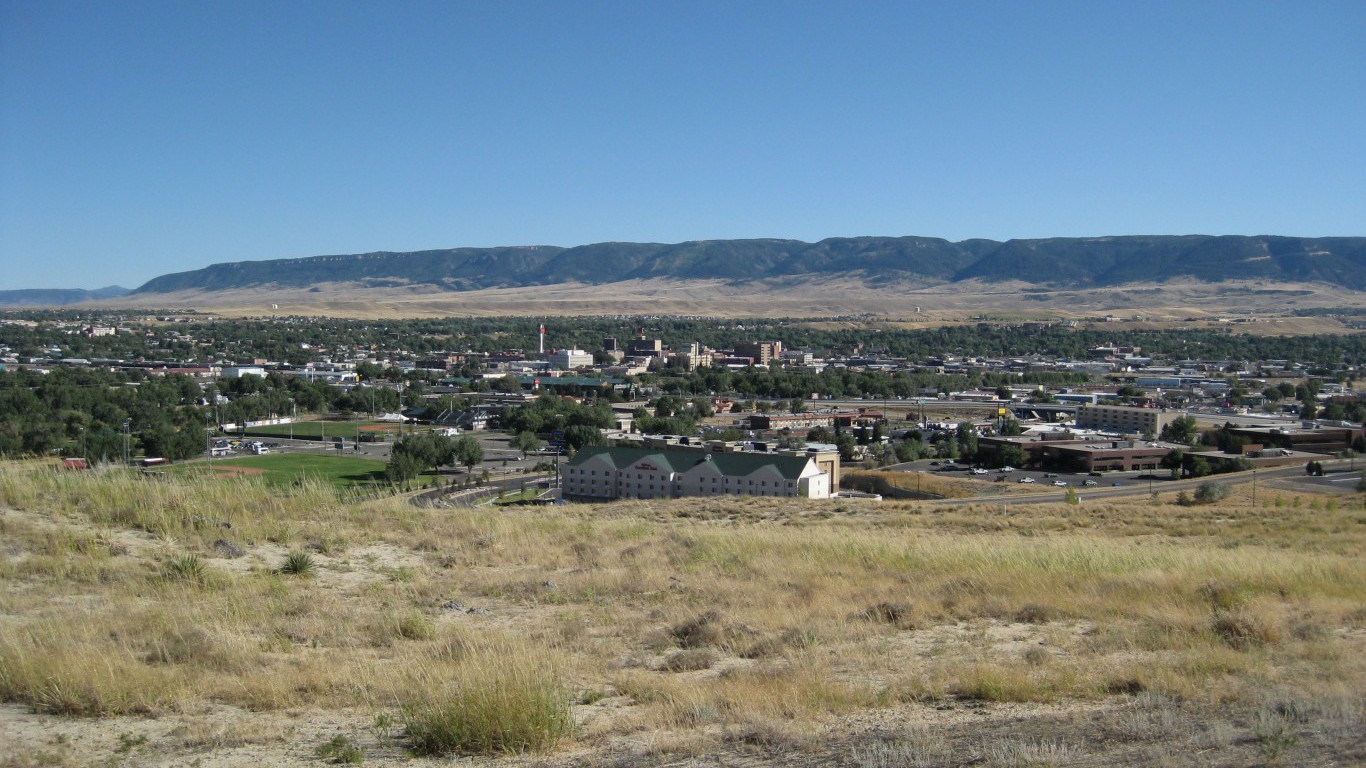
6. Casper, WY
> Employment decline: -6.1%
> Number of jobs June 2012: 40,115
> Number of jobs June 2016: 37,649
> Unemployment rate June 2016: 7.7%
Casper is one of the only metro areas where the population grew over the last four years as the total number of jobs fell. While population growth is usually a strong indication of economic health, this may not be the case in Casper. The area’s unemployment rate rose from 5.0% of the workforce to 7.7%.

5. Binghamton, NY
> Employment decline: -6.2%
> Number of jobs June 2012: 109,202
> Number of jobs June 2016: 102,483
> Unemployment rate June 2016: 5.1%
The bulk of the Binghamton metro area’s employment decline occurred in its largest sector, government. The number of area residents employed by the local government fell by 7.6%, while nationwide it grew by 0.9%.

4. Peoria, IL
> Employment decline: -6.4%
> Number of jobs June 2012: 183,130
> Number of jobs June 2016: 171,350
> Unemployment rate June 2016: 6.6%
Total employment in Peoria fell by 6.4% over the past four years, one of the largest declines of any metro area. The unemployment rate fell from 7.8% to 6.6% over the same period — one of the smallest improvements of any metro area economy.

3. Pine Bluff, AR
> Employment decline: -6.6%
> Number of jobs June 2012: 36,984
> Number of jobs June 2016: 34,549
> Unemployment rate June 2016: 5.4%
Total employment in Pine Bluff has fallen by 6.6% since 2012, while nationwide it grew by 7.6%. Workers who lost or left their jobs may be among the many residents moving out of Pine Bluff. The metro area population fell by 3.8%, the third largest decline.

2. Beckley, WV
> Employment decline: -6.6%
> Number of jobs June 2012: 46,418
> Number of jobs June 2016: 43,357
> Unemployment rate June 2016: 7.1%
Total employment in Beckley has fallen by 6.6% since 2012, while nationwide it grew by 7.6%. The unemployment rate fell from 7.8% to 7.1% over the same period — one of the smallest improvements of any metro area economy.

1. Atlantic City-Hammonton, NJ
> Employment decline: -6.8%
> Number of jobs June 2012: 122,981
> Number of jobs June 2016: 114,580
> Unemployment rate June 2016: 7.4%
The Atlantic City-Hammonton metro area leads the nation for job losses, with a four-year employment decline of 6.8%. Many of the jobs lost in the area were in its largest sector, leisure and hospitality. Employment in the leisure and hospitality industry fell by 21.9%, one of the largest contractions nationwide.
It’s Your Money, Your Future—Own It (sponsor)
Are you ahead, or behind on retirement? For families with more than $500,000 saved for retirement, finding a financial advisor who puts your interest first can be the difference, and today it’s easier than ever. SmartAsset’s free tool matches you with up to three fiduciary financial advisors who serve your area in minutes. Each advisor has been carefully vetted and must act in your best interests. Start your search now.
If you’ve saved and built a substantial nest egg for you and your family, don’t delay; get started right here and help your retirement dreams become a retirement reality.
Thank you for reading! Have some feedback for us?
Contact the 24/7 Wall St. editorial team.
 24/7 Wall St.
24/7 Wall St. 24/7 Wall St.
24/7 Wall St. 24/7 Wall St.
24/7 Wall St.



